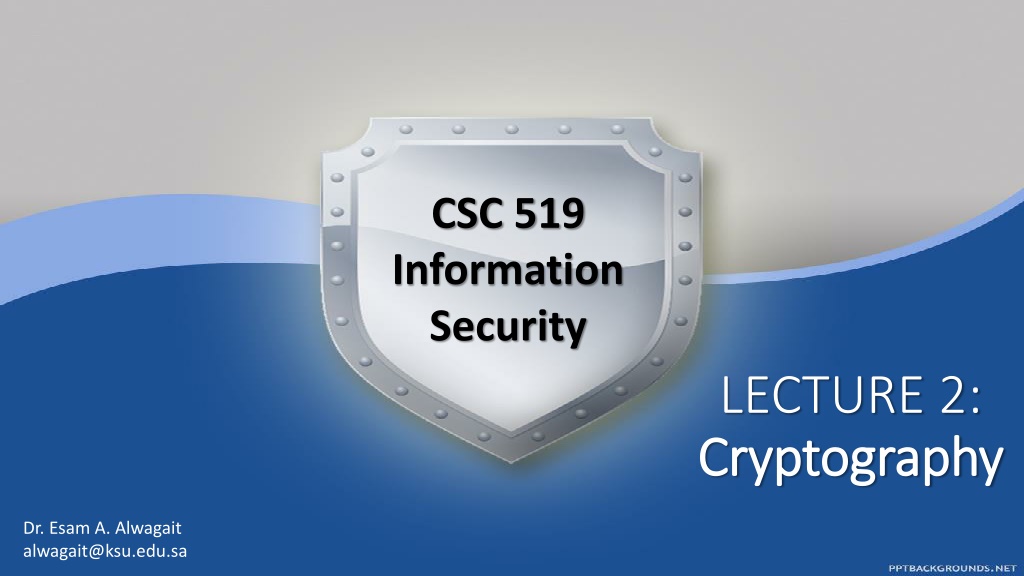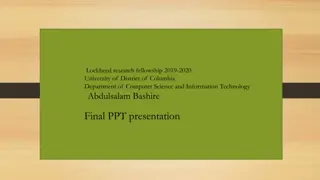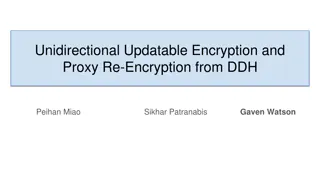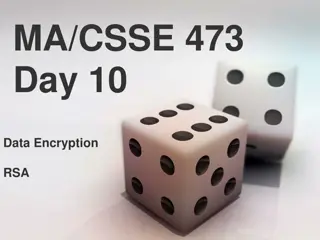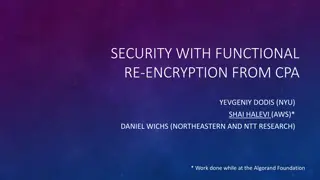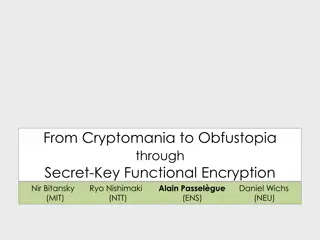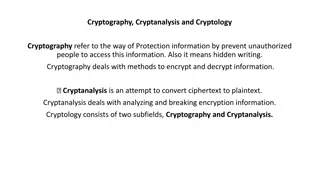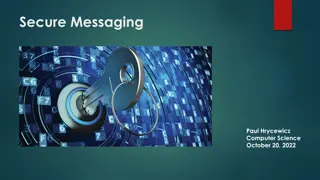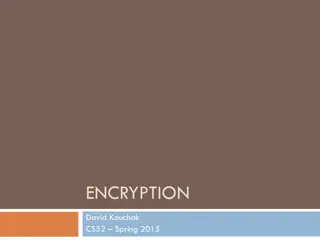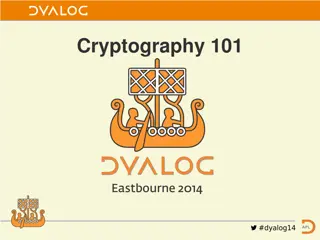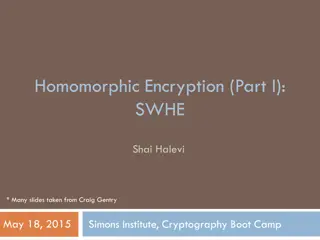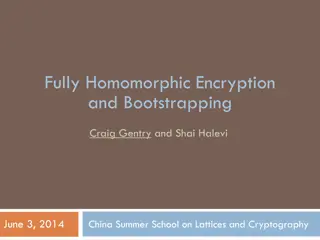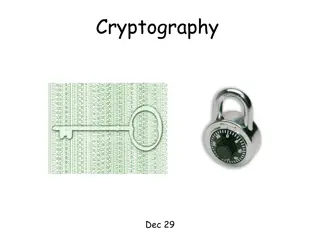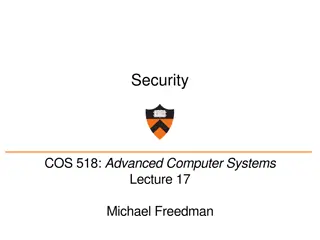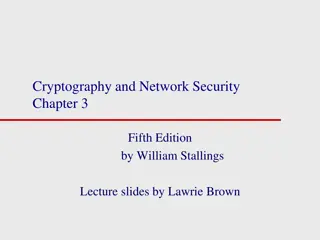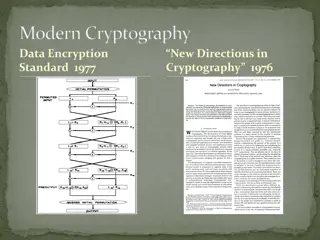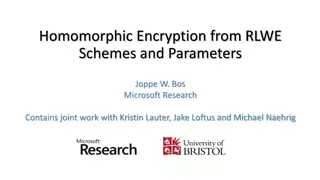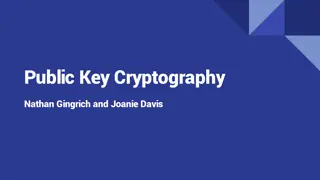Cryptography Concepts and Encryption Methods Overview
Exploring elementary cryptography concepts such as encryption, cryptanalysis, symmetric and asymmetric encryption algorithms like DES, AES, and RSA. Delve into key exchange protocols, digital signatures, cryptographic hash functions, and the process of encryption and decryption in a cryptosystem.
Download Presentation

Please find below an Image/Link to download the presentation.
The content on the website is provided AS IS for your information and personal use only. It may not be sold, licensed, or shared on other websites without obtaining consent from the author. Download presentation by click this link. If you encounter any issues during the download, it is possible that the publisher has removed the file from their server.
E N D
Presentation Transcript
CSC 519 Information Security LECTURE 2: Cryptography Cryptography Dr. Esam A. Alwagait alwagait@ksu.edu.sa
Module 2: Elementary Cryptography Concepts of Encryption Cryptanalysis: how encryption systems are broken Symmetric (secret key) encryption and the DES and AES algorithms Asymmetric (public key) encryption and the RSA algorithm Key exchange protocols and certificates Digital signatures Cryptographic hash functions CSC 519 Information Security
Concepts of Encryption Cryptography is rooted in higher mathematics: group and field theory computational complexity E.g. the question of the extent to which a problem is solvable on a computer real analysis the theory of functions of a real variable In addition to probability and statistics CSC 519 Information Security
Concepts of Encryption Consider the steps involved in sending messages from a sender, S, to a recipient, R If S entrusts the message to T, who then delivers it to R, T then becomes the transmission medium. If an outsider, O, wants to access the message (to read, change, or even destroy it), we call O an interceptor or intruder CSC 519 Information Security
Concepts of Encryption O might try to access the message in any of the following ways: Block it, by preventing its reaching R, thereby affecting the availability of the message. Intercept it, by reading or listening to the message, thereby affecting the confidentiality of the message. Modify it, by seizing the message and changing it in some way, affecting the message's integrity. Fabricate an authentic-looking message, arranging for it to be delivered as if it came from S, thereby also affecting the integrity of the message A message's vulnerabilities reflect the four possible security failures we identified earlier. CSC 519 Information Security
Terminology Encryption is the process of encoding a message so that its meaning is not obvious Decryption is the reverse process, transforming an encrypted message back into its normal, original form Alternatively, the terms encode and decode or encipher and decipher are used instead of encrypt and decrypt We say that we encode, encrypt, or encipher the original message to hide its meaning We decode, decrypt, or decipher it to reveal the original message A system for encryption and decryption is called a cryptosystem CSC 519 Information Security
Terminology Slight difference (not significant in this course): encoding is the process of translating entire words or phrases to other words or phrases enciphering is translating letters or symbols individually encryption is the group term that covers both encoding and enciphering CSC 519 Information Security
Terminology The original form of a message is known as plaintext The encrypted form is called ciphertext We denote a plaintext message P as a sequence of individual characters P = <p1, p2, , pn> Similarly, ciphertext is written as C = <c1, c2, , cm> Encryption CSC 519 Information Security
Terminology Example: The plaintext message "I want cookies" can be denoted as the message string <I, ,w,a,n,t, , c,o,o,k,i,e,s> It can be transformed into ciphertext <c1, c2, , c14>, and the encryption algorithm tells us how the transformation is done Encryption CSC 519 Information Security
Terminology We use this formal notation to describe the transformations between plaintext and ciphertext We write C = E(P) and P = D(C), where C represents the ciphertext E is the encryption rule P is the plaintext, and D is the decryption rule What we seek is a cryptosystem for which P = D(E(P)) In other words, we want to be able to convert the message to protect it from an intruder, but we also want to be able to get the original message back so that the receiver can read it properly CSC 519 Information Security
Terminology The cryptosystem involves a set of rules for how to encrypt the plaintext and how to decrypt the ciphertext The encryption and decryption rules, called algorithms, often use a device called a key, denoted by K, so that the resulting ciphertext depends on the original plaintext message, the algorithm, and the key value We write this dependence as C = E(K, P) This process is similar to using mass-produced locks in houses! Expensive if every lock is designed separately Few well-known companies produce standard locks that differ according to the key! CSC 519 Information Security
Terminology Cryptography means hidden writing using encryption to conceal text A cryptanalysis is studying encryption and encrypted messages, hoping to find the hidden meanings Both a cryptographer and a cryptanalyst attempt to translate coded material back to its original form But, a cryptographer normally works on behalf of a legitimate sender or receiver, whereas a cryptanalyst works on behalf of an unauthorized interceptor Cryptology is the research into and study of encryption and decryption it includes both cryptography and cryptanalysis CSC 519 Information Security
Concepts Cryptography hidden writing Encryption encode or encipher Decryption decode or decipher Cryptosystem a system for encryption and decryption Cryptographer anyone who invents encryption algorithms Cryptanalyst anyone who attempts to break encryption algorithms Cryptology research of encryption and decryption, including both cryptography and cryptanalysis CSC 519 Information Security 13
Concepts of symmetric and asymmetric encryption Symmetric : the encryption and decryption keys are the same, so P = D(K, E(K,P)). D and E are mirror-image processes Asymmetric: encryption and decryption keys come in pairs. Then, a decryption key, KD, inverts the encryption of key KE so that P = D(KD, E(KE,P)) converting C back to P involves a series of steps and a key that are different from the steps and key of E CSC 519 Information Security
Why using a key? We can create different encryptions of one plaintext message just by changing the key Using a key provides additional security If the encryption algorithm should fall into the interceptor's hands, future messages can still be kept secret because the interceptor will not know the key value CSC 519 Information Security
What can a cryptanalyst attempt to do? Break a single message Recognize patterns in encrypted messages to be able to break subsequent ones by applying a straightforward decryption algorithm Infer some meaning without even breaking the encryption such as noticing an unusual frequency of communication or determining something by whether the communication was short or long Deduce the key to break subsequent messages easily Find weaknesses in the implementation or environment of use of encryption Find general weaknesses in an encryption algorithm, without necessarily having intercepted any messages CSC 519 Information Security
What can a cryptanalyst attempt to do? Cryptanalyst cannot be expected to try only the hard, long way! analyst can use educated guesses combined with careful analysis to generate all or most of an important message Example: WWII 1942 (AF for Midway island between US and Japanese) Estimates of breakability are based on current technology, not future! Things that were infeasible in 1940 became possible by the 1950s Remember "Moore's Law" the speed of processors doubles every 1.5 years, and this conjecture has been true for over two decades CSC 519 Information Security
Representing Characters Use the mathematical form below The letter A is represented by a zero, B by a one, and so on We can perform simple modular arithmetic on letters using the corresponding code numbers A + 4 = E, K - 2 = I, Y + 3 = B CSC 519 Information Security
Substitutions & transpositions Two simple forms of encryption: Substitutions in which one letter is exchanged for another Transpositions in which the order of the letters is rearranged CSC 519 Information Security
Substitutions: : The Caesar Cipher The Caesar Cipher Each letter is translated to the letter a fixed number of places after it in the alphabet. Caesar used a shift of 3, so plaintext letter pi was enciphered as ciphertext letter ci by the rule ci = E(pi) = (pi + 3) mod (26) In the general form, using K as a key ci= E(pi) = (pi+ k) mod (26) pi= D(ci) = (ci k) mod (26) Example: INFO SECURITY ? Was it good enough? CSC 519 Information Security
Substitutions: : The Caesar Cipher Cyphertext: wklv phvvdjh lv qrw wrr kdug wr euhdn Cryptanalysis: Blank is translated to itself? How about English small words? (digrams and trigrams) am, is, to, be, he, we, and, are, you, she, and so on Any clue in the repeated r of wrr? Xyy: see, too, odd, add wklv phvvdjh lv qrw wrr kdug wr euhdn T--- ------- -- -OT TOO ---- TO ----- How about OT? Could be got, dot, hot, etc. CSC 519 Information Security
To be continued next lecture! Other symmetric cryptography Asymmetric cryptography CSC 519 Information Security
